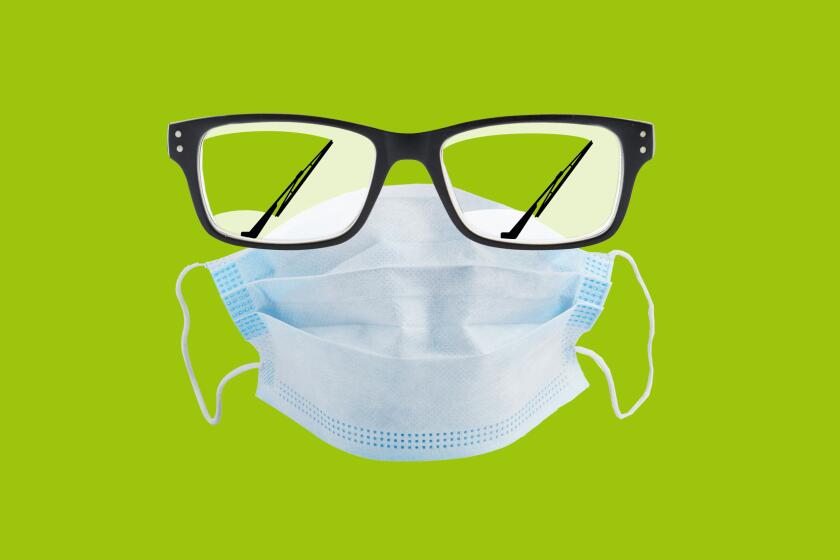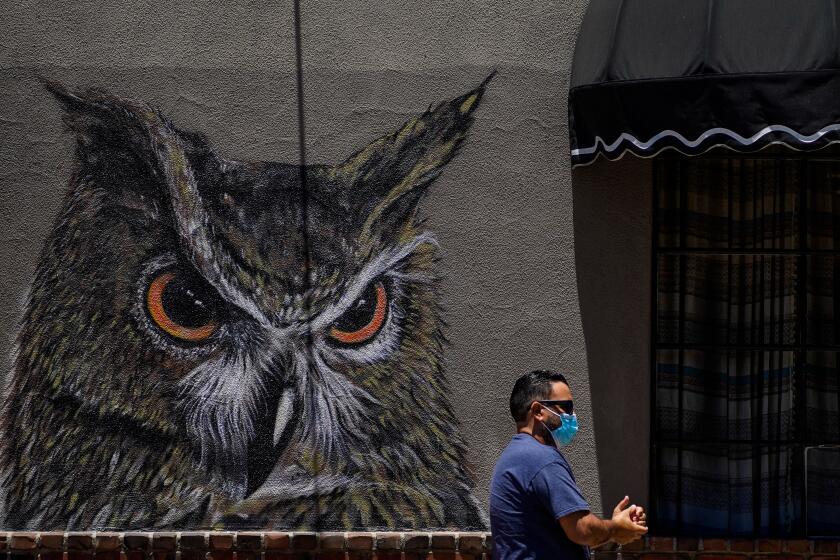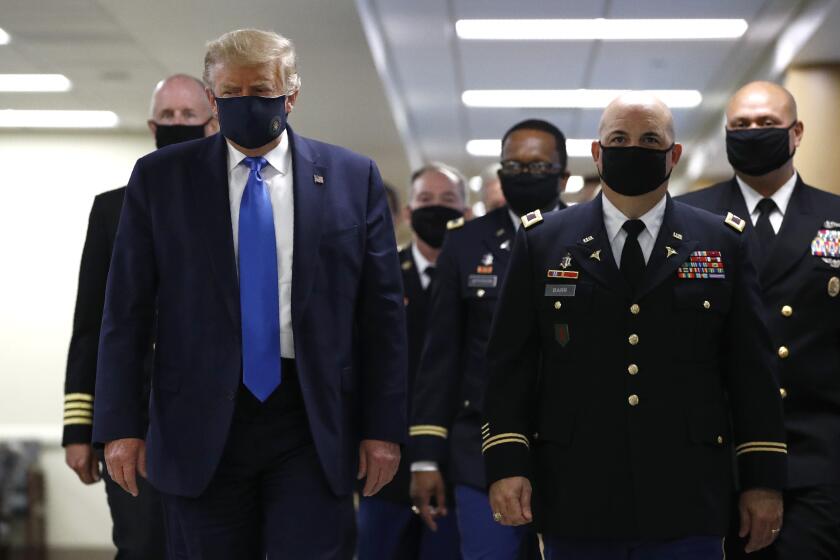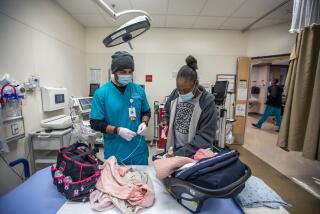Masks offer much more protection against coronavirus than many think

- Share via
SAN FRANCISCO — There’s a common refrain that masks don’t protect you; they protect other people from your own germs, which is especially important to keep unknowingly infected people from spreading the coronavirus.
But now, there’s mounting evidence that masks also protect you.
If you’re unlucky enough to encounter an infectious person, wearing any kind of face covering will reduce the amount of virus that your body will take in.
As it turns out, that’s pretty important. Breathing in a small amount of virus may lead to no disease or far more mild infection. But inhaling a huge volume of virus particles can result in serious disease or death.
That’s the argument Dr. Monica Gandhi, UC San Francisco professor of medicine and medical director of the HIV Clinic at Zuckerberg San Francisco General Hospital, is making about why — if you do become infected with the virus — masking can still protect you from more severe disease.
“There is this theory that facial masking reduces the [amount of virus you get exposed to] and disease severity,” said Gandhi, who is also director for the Center for AIDS Research at UC San Francisco.
The idea of requiring mask-wearing in public has become an increasingly pressing and politicized issue as California and the rest of the nation see a surge in new cases as the economy reopens.
California this week ordered a reclosure of many businesses, include a statewide halt to all indoor dining and the closure of bars. The state also ordered the closure — in dozens of hard-hit counties, including L.A. County — of indoor gyms, houses of worship, hair salons, nail salons and offices for nonessential industries.
But experts say masks are essential for people to wear when they go out in public, such as to shop or go to medical appointments, and when close to other people at the beach or park.
Wearing masks will help minimize the spread of COVID-19. Here’s how to do it right.
California has mandated face coverings in public settings since June 18, and a growing number of communities say they will ticket people who disobey the rules. But there remains resistance to the government mandating wearing masks in some corners of the state, including Orange County.
Some leaders in Orange County have pushed back against requiring students to wear masks should they return to classrooms in the fall.
In policy recommendations approved by the Orange County Board of Education on Monday, a document stated that “requiring children to wear masks during school is not only difficult — if not impossible to implement — but [is] not based on science. It may even be harmful.” Individual districts will have the final say on how schools open.
Some health experts were appalled by that language.
“This anti-mask rhetoric is mind-blowing, dangerous, deadly and polarizing,” said Dr. Peter Chin-Hong, professor of medicine and an infectious diseases specialist at UC San Francisco. “There is no evidence that it is dangerous.”
In California, mandatory face coverings that experts say reduce the spread of the coronavirus are at the center of an intense political fight.
In fact, wearing masks can help prevent children from being infected and suffering serious consequences of infection, such as multisystem inflammatory syndrome, a rare condition that has been seen in children who have been infected with the coronavirus. “Kids not only transmit, but they can get sick as well,” Chin-Hong said.
While children are less likely to develop severe illness from the coronavirus than adults, they can still be infected, be contagious and transmit the virus to other people, Gandhi said.
Wearing a mask at school would not only reduce their ability to transmit the virus to other classmates, teachers and administrators, but also protect the students from getting infected with a large dose of virus from infected people.
Transmission rates for coronavirus have been rising across the state. Nearly 1,000 of San Francisco’s nearly 4,600 cases have been diagnosed in just the last two weeks, said Dr. Grant Colfax, the city’s director of public health.
In San Francisco, nearly half of all those who have tested positive in the city are Latinos, he said, even though Latino residents make up just 15% of the city’s population. Overall, the city has seen 7.8 new infections per 100,000 residents over the last seven days, far above its goal of no more than 1.8 new infections per 100,000 people.
“This, again, indicates that the virus is spreading throughout the city, particularly ... in the southeast part of the city,” Colfax said.
For every one person who contracts the virus, another 1.25 people on average are now infected, he said. “We really need to drive that down to 1 or below as quickly and as soon as possible.”
The transmission rate also rose above 1 in L.A. County in June, but has fallen back to 1. “The virus currently rages on in our community,” Public Health Director Barbara Ferrer said.
The reason why masks are so important in controlling the spread of the coronavirus is that it can be widely spread by people who are not visibly sick — either because they haven’t yet shown signs of illness, or they will spend the entire course of their infections with little or no symptoms at all.
A key piece of evidence for this emerged earlier this year, on the Diamond Princess cruise ship that carried infected crew and passengers in Asia. A study published by the U.S. Centers for Disease Control and Prevention found that of 712 people testing positive for the virus, nearly half were asymptomatic at the time of testing.
“We also know that viral load is highest early during disease,” said Dr. Chaz Langelier, an assistant professor at UC San Francisco, during the panel discussion. In fact, 44% of transmissions are believed to occur when the infected person has no symptoms, according to a study published in Nature Medicine.
That’s different from the seasonal flu, where peak infectiousness occurs about one day after the onset of symptoms, Langelier said.
Masks don’t filter out all viral particles, Gandhi said. But even cloth face masks filter out a majority of viral particles.
And even if a person wearing a mask gets infected, the mask — by filtering out most of the viral particles exhaled by the infected person — probably leads to less severe disease, Gandhi said.
The idea that a lower dose of virus when being infected brings less illness is a well-worn idea in medicine.
Even going back to 1938, there was a study showing that by giving mice a higher dose of a deadly virus, the mice were more likely to get severe disease and die, Gandhi said.
The same principle applies to humans. A study published in 2015 gave healthy volunteers varying doses of a flu virus; those who got higher doses got sicker, with more coughing and shortness of breath, Gandhi said.
And another study suggested that the reason the second wave of the 1918-19 flu pandemic was the deadliest in the U.S. was because of the overcrowded conditions faced in Army camps as World War I wound down. “In 1918, the Army camps [were] characterized by a high number of contacts between people and by a high case-fatality rate, sometimes 5 to 8 times higher than the case-fatality rate among civilian communities,” the study said.
Finally, a study published in May found that surgical mask partitions significantly reduced the transmission of the coronavirus among hamsters. And even if the hamsters protected by the mask partitions acquired the coronavirus, “they were more likely to get very mild disease,” Gandhi said.
When President Trump wore a mask in public for the first time during this pandemic, his allies treated it as a political win. It marked a big shift from his previous stance.
So what happens if a city dramatically masks up while in public?
If Gandhi is right, it may mean that even if there’s a rise in coronavirus infections in a city, the masks may limit the dose of virus people are getting and result in less severe symptoms of illness.
That’s what Gandhi said she suspects is happening in San Francisco, where mask wearing is relatively robust. Further observations are needed, Gandhi said.
There’s more evidence that masks can be protective — even when wearers do become infected. She cited an outbreak at a seafood plant in Oregon where employees were given masks, and 95% of those who were infected were asymptomatic.
Gandhi also cited the experience of a cruise ship that was traveling from Argentina to Antartica in March when the coronavirus infected people on board, as documented in a recent study. Passengers got surgical masks; the crew got N95 masks.
But instead of about 40% of those infected being asymptomatic — which is what would normally be expected — 81% of those testing positive were asymptomatic, and the masking may have helped reduce the severity of disease in people on board, Gandhi said.
The protective effects are also seen in countries where masks are universally accepted for years, such as Taiwan, Thailand, South Korea and Singapore. “They have all seen cases as they opened ... but not deaths,” Gandhi said.
The Czech Republic moved early to require masks, issuing an order in mid-March, Gandhi said; that’s about three months before Gov. Gavin Newsom did so statewide in California. But in the Czech Republic, “every time their cases would go up ...their death rate was totally flat. So they didn’t get the severe illness with these cases going on.”
By May, the Czech Republic lifted its face mask rule. “And they’re doing great,” Gandhi said.
More to Read
Sign up for Essential California
The most important California stories and recommendations in your inbox every morning.
You may occasionally receive promotional content from the Los Angeles Times.















